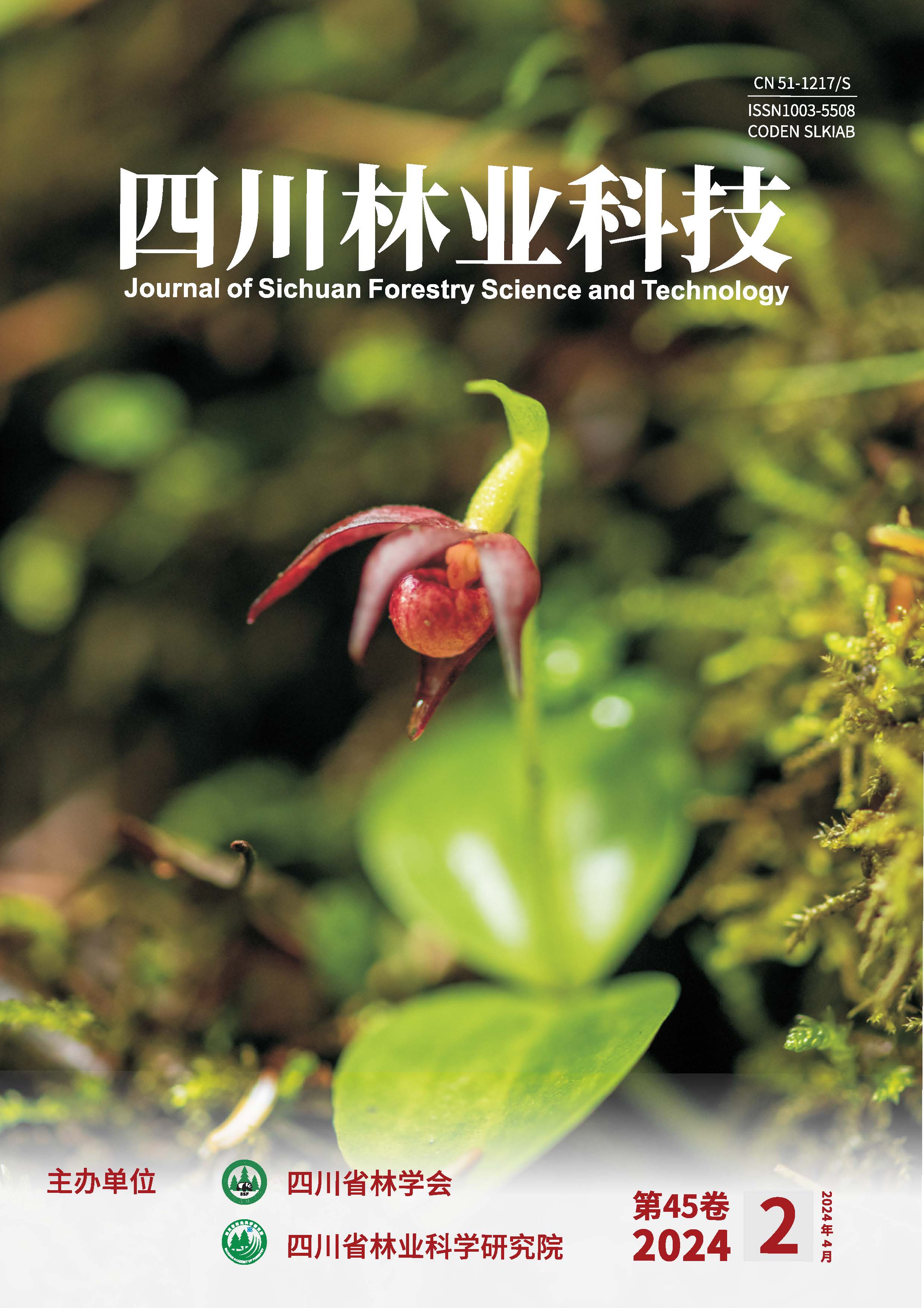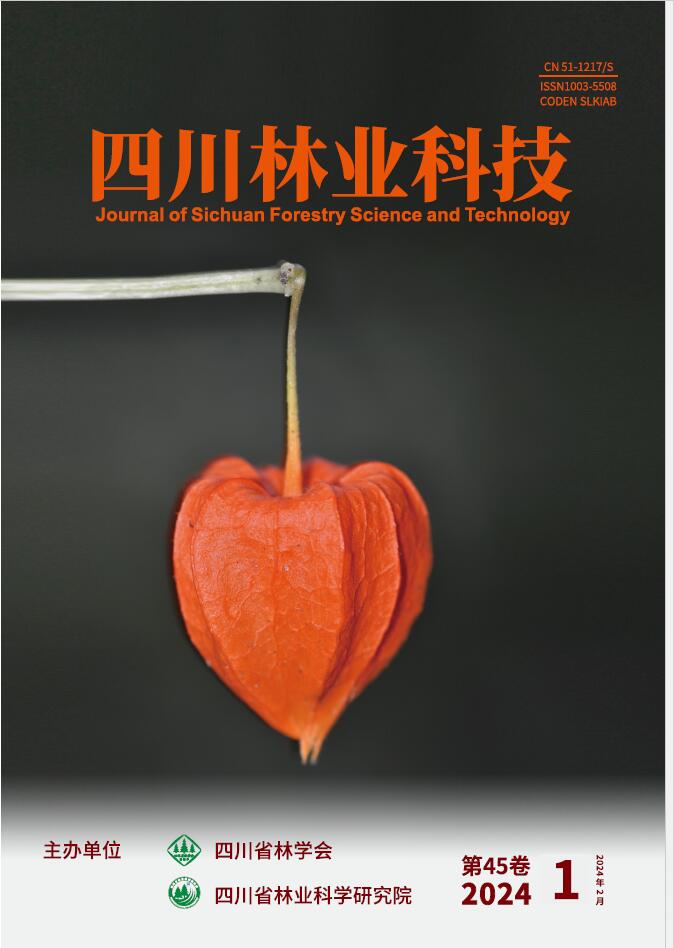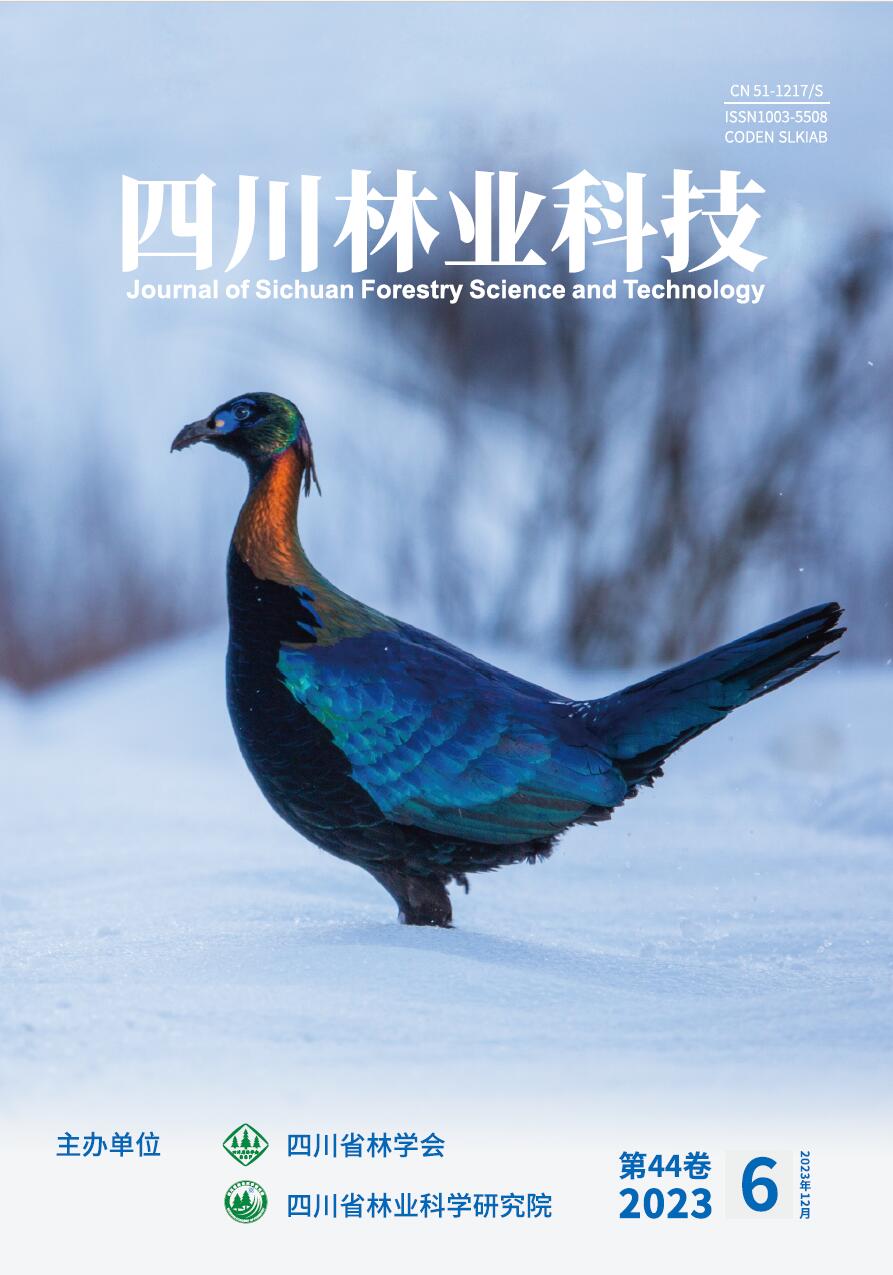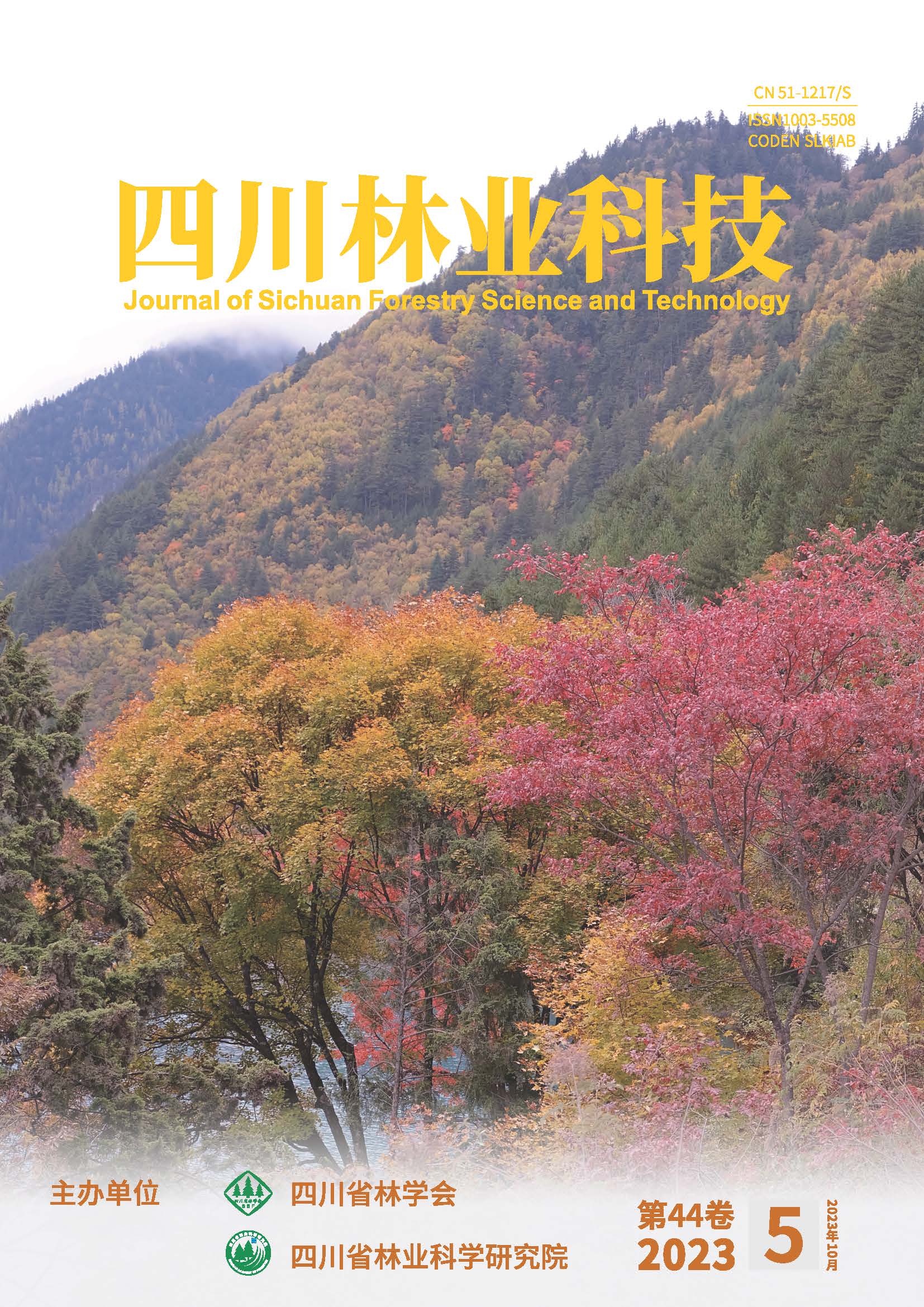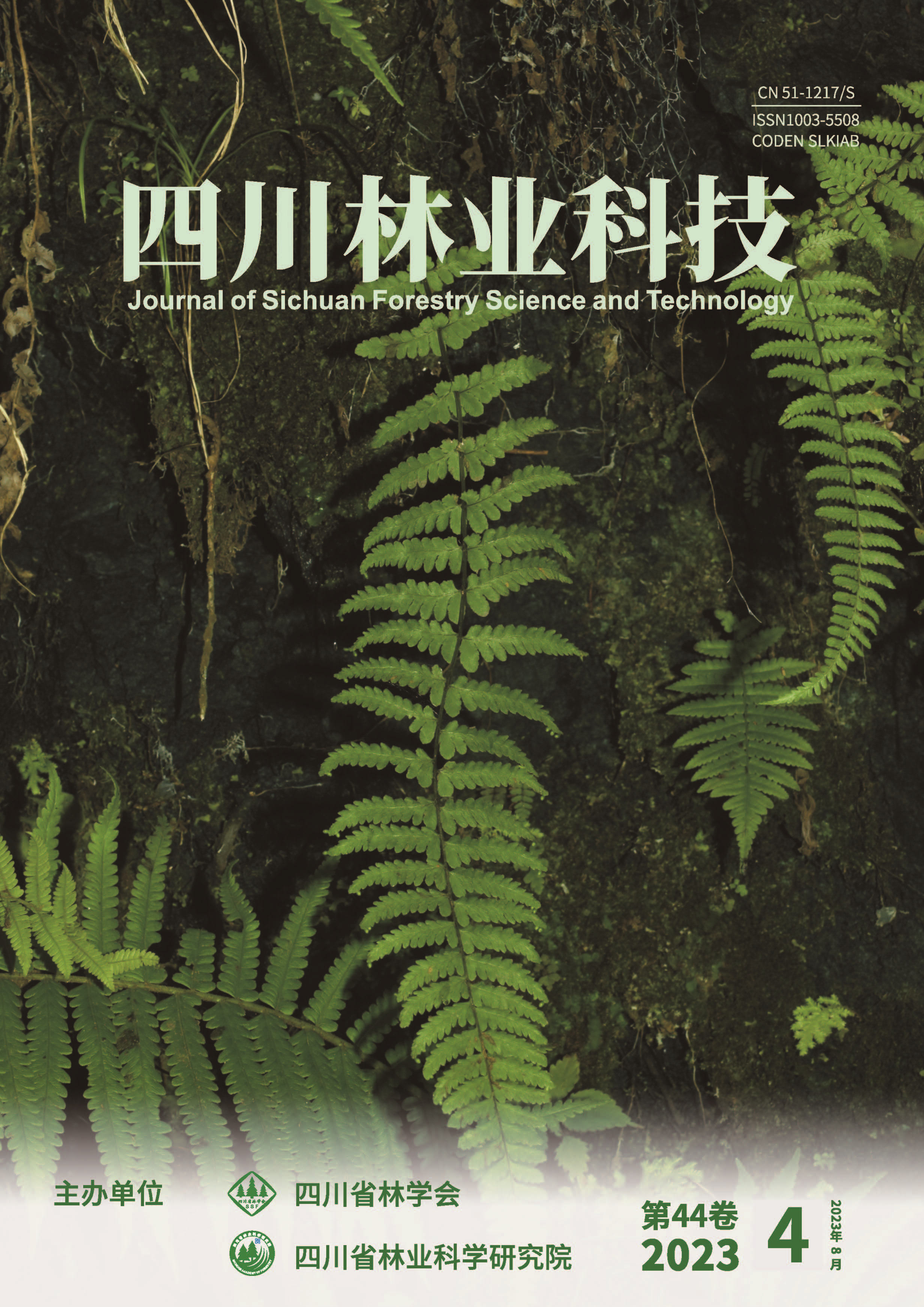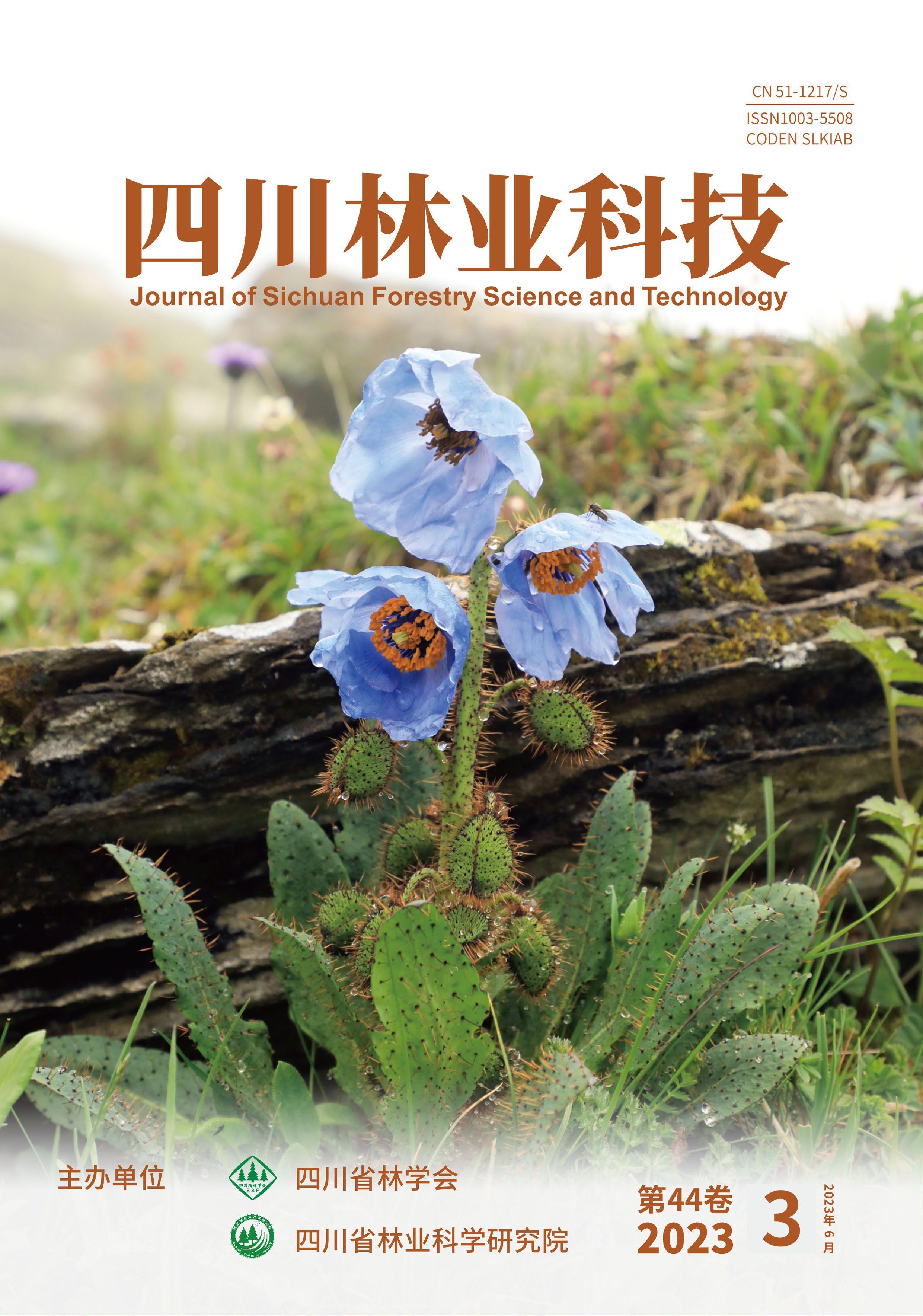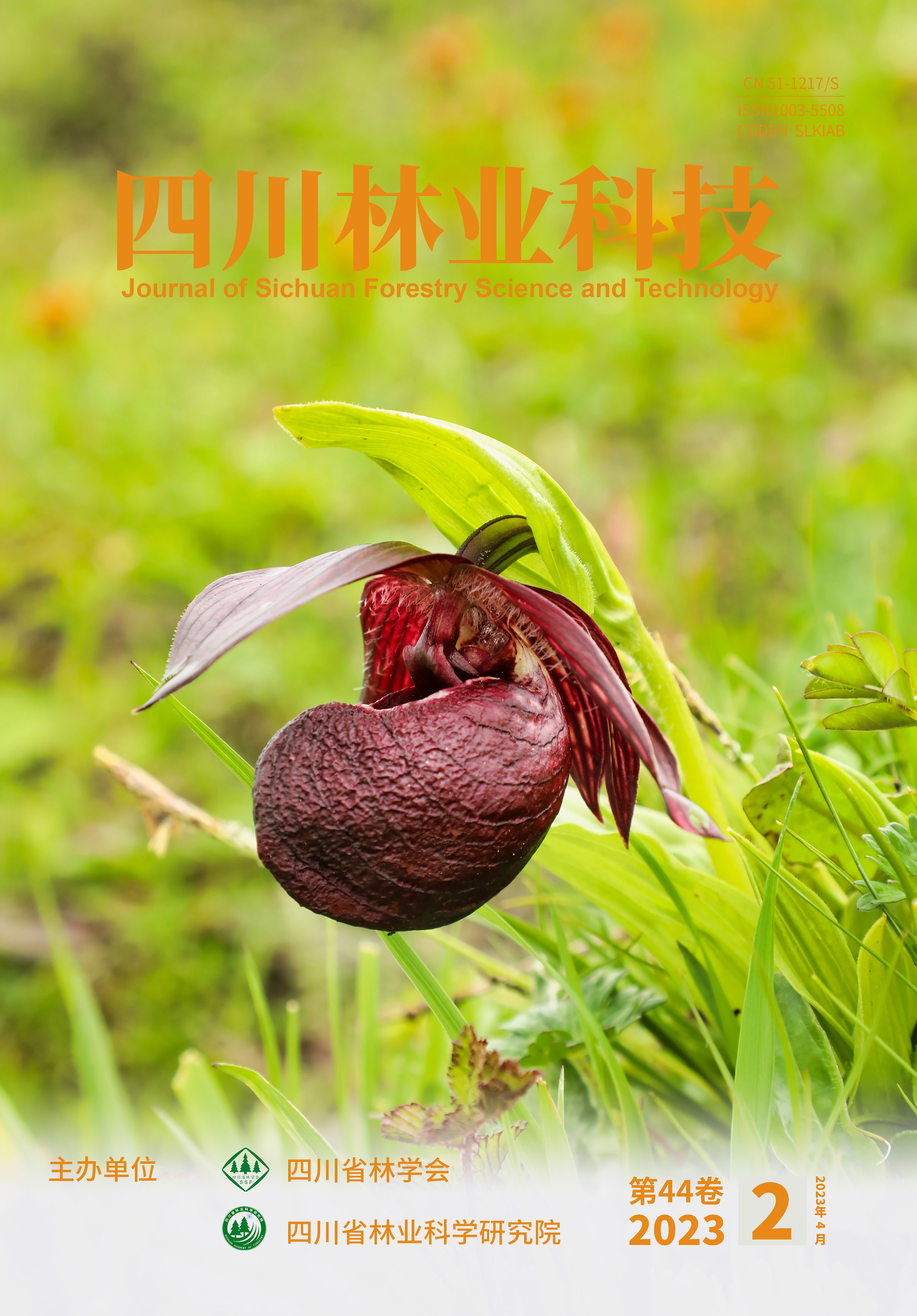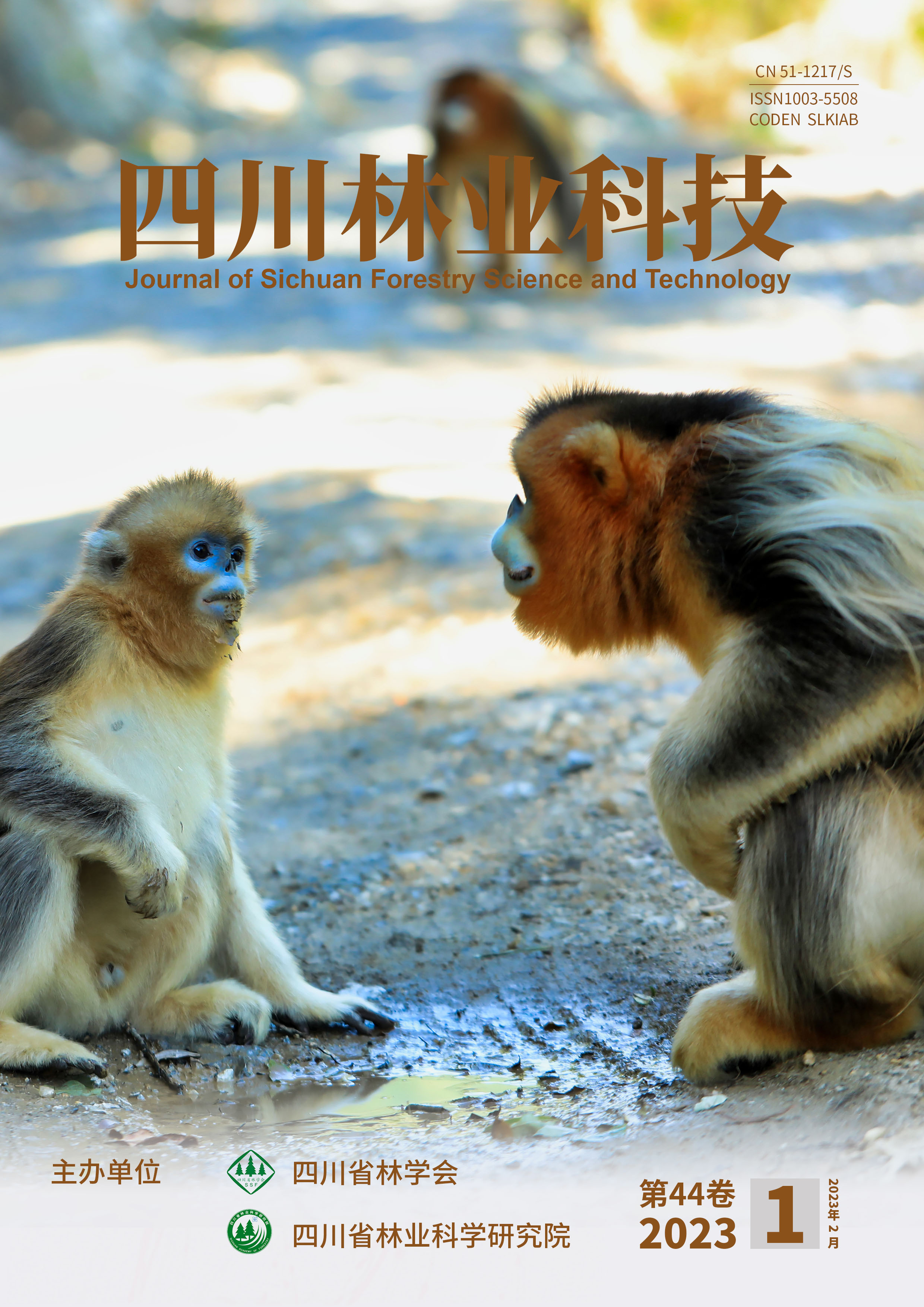2018 Vol. 39 Issue 6
2018 Vol. 39, No. 6
Export
Citation
2018, 39(6): 1-6.
doi: 10.16779/j.cnki.1003-5508.2018.06.001
Abstract:
In order to study the effects of different cutting bands on the species diversity and the growth of cypress trees in the pure cypress forest with 35~40 years old and poor natural regeneration in the hilly area of central Sichuan. In 2011, 2012, 2014 and 2016,investigations were made on the species diversity of understory plants and annual growth of cypress trees. The data analysis showed that different cutting zones had different effects on the biodiversity index and stand growth of shrub and herbage layers. With the increase of years, the species diversity index of 8 m and 10 m wide shrubs was higher than that of other bandwidth, and significantly higher than that of the control group (P<0.05), but the diversity index of herbaceous species showed a gradual decrease relative to the shrub species diversity. Average annual growth of plant height and DBH of the reserved cypress were significantly higher than those of the control group (P<0.05). The highest annual growth of 8 m and 10 m wide reserved cypress was found in the reserved cypress. For the five treatments, the suitable cutting bands for improving the plant diversity under the inefficient cypress plantation should have the width of 8 m and 10 m.
In order to study the effects of different cutting bands on the species diversity and the growth of cypress trees in the pure cypress forest with 35~40 years old and poor natural regeneration in the hilly area of central Sichuan. In 2011, 2012, 2014 and 2016,investigations were made on the species diversity of understory plants and annual growth of cypress trees. The data analysis showed that different cutting zones had different effects on the biodiversity index and stand growth of shrub and herbage layers. With the increase of years, the species diversity index of 8 m and 10 m wide shrubs was higher than that of other bandwidth, and significantly higher than that of the control group (P<0.05), but the diversity index of herbaceous species showed a gradual decrease relative to the shrub species diversity. Average annual growth of plant height and DBH of the reserved cypress were significantly higher than those of the control group (P<0.05). The highest annual growth of 8 m and 10 m wide reserved cypress was found in the reserved cypress. For the five treatments, the suitable cutting bands for improving the plant diversity under the inefficient cypress plantation should have the width of 8 m and 10 m.
2018, 39(6): 7-12.
doi: 10.16779/j.cnki.1003-5508.2018.06.002
Abstract:
Aiming to understand the variation character of various nitrogen compositions in typical alpine swamp soil,three sites with different ground water tables in Zoige Plateau were selected as test objects in August 2017, soil samples from different layers(0~20 cm, 20~40 cm, 40~60 cm, 60~80 cm)were determined. The result showed that there was significant vertical variation by soil profile in total nitrogen (TN), effective nitrogen (EN), nitrate nitrogen (NN), organic nitrogen (DON). In different layers, there was regular distribution (PM > SM > GM) by wetland types. Nevertheless, ammonia nitrogen (AN) showed considerable spatial variability and less distribution rules, there was significant positive relationship between any two of soil nitrogen compositions. In conclusion:EN, NN and DON will be of great importance in indicating the alpine swamp wetland degradation.
Aiming to understand the variation character of various nitrogen compositions in typical alpine swamp soil,three sites with different ground water tables in Zoige Plateau were selected as test objects in August 2017, soil samples from different layers(0~20 cm, 20~40 cm, 40~60 cm, 60~80 cm)were determined. The result showed that there was significant vertical variation by soil profile in total nitrogen (TN), effective nitrogen (EN), nitrate nitrogen (NN), organic nitrogen (DON). In different layers, there was regular distribution (PM > SM > GM) by wetland types. Nevertheless, ammonia nitrogen (AN) showed considerable spatial variability and less distribution rules, there was significant positive relationship between any two of soil nitrogen compositions. In conclusion:EN, NN and DON will be of great importance in indicating the alpine swamp wetland degradation.
2018, 39(6): 13-19.
doi: 10.16779/j.cnki.1003-5508.2018.06.003
Abstract:
The study collected phytoncidere from living leaves and branches of 5 forest health species:Cupressus funebris, Pinus massoniana, Cryptomeria fortune, Cinnamomum septentrionale and Pleioblastus amarus in Sichuan, and analyzed the chemical components and their relative content in the phytoncidere by gas chromatography-mass spectrometry (GC/MS). The results showed that six kinds of VOCS, terpenes, alcohols, esters, aldehydes, ketones and alkanes were the main components of phytoncidere in the living branches and leaves of 5 forest health species. The main components released from living branches and leaves of Cupressus funebris, Pinus massoniana, Cryptomeria fortune and Cinnamomum septentrionale were monoterpenes and sesquiterpenes, whose contents were more than 60%, which had stronger physiological function. The contents of alkane and α-pinene in terpene in the living branches and leaves of Pleioblastus amarus were the highest.
The study collected phytoncidere from living leaves and branches of 5 forest health species:Cupressus funebris, Pinus massoniana, Cryptomeria fortune, Cinnamomum septentrionale and Pleioblastus amarus in Sichuan, and analyzed the chemical components and their relative content in the phytoncidere by gas chromatography-mass spectrometry (GC/MS). The results showed that six kinds of VOCS, terpenes, alcohols, esters, aldehydes, ketones and alkanes were the main components of phytoncidere in the living branches and leaves of 5 forest health species. The main components released from living branches and leaves of Cupressus funebris, Pinus massoniana, Cryptomeria fortune and Cinnamomum septentrionale were monoterpenes and sesquiterpenes, whose contents were more than 60%, which had stronger physiological function. The contents of alkane and α-pinene in terpene in the living branches and leaves of Pleioblastus amarus were the highest.
2018, 39(6): 20-24,39.
doi: 10.16779/j.cnki.1003-5508.2018.06.004
Abstract:
In order to study the habitat of giant pandas in wildness training program, a sample survey was conducted in the second-phase wildness training pen located in Wolong Nature Reserve from November to December in 2016. The results showed that food factor,shrub factor,tree factor and slope factor would affect the habitat selection of giant pandas during wildness training. Giant pandas mostly chose to forage in bamboo forests with density of 20 Culm·m-2~40 Culm·m-2, height of 1 m~2 m and bamboo clump coverage of more than 70%. They preferred to move in shrub layer with shrub coverage of more than 90%, shrub height of less than 3 cm at breast height of less than 5 m and density of less than 0.1 Culm·m-2. They would select the tree layers with canopy density of 0.5~0.7, DBH 10 cm~20 cm, height 1 020 m and density 0.05 Culm·m-2~0.1 Culm·m-2. They tended to choose the middle and lower slope positions with a slope of 20° to 30°.
In order to study the habitat of giant pandas in wildness training program, a sample survey was conducted in the second-phase wildness training pen located in Wolong Nature Reserve from November to December in 2016. The results showed that food factor,shrub factor,tree factor and slope factor would affect the habitat selection of giant pandas during wildness training. Giant pandas mostly chose to forage in bamboo forests with density of 20 Culm·m-2~40 Culm·m-2, height of 1 m~2 m and bamboo clump coverage of more than 70%. They preferred to move in shrub layer with shrub coverage of more than 90%, shrub height of less than 3 cm at breast height of less than 5 m and density of less than 0.1 Culm·m-2. They would select the tree layers with canopy density of 0.5~0.7, DBH 10 cm~20 cm, height 1 020 m and density 0.05 Culm·m-2~0.1 Culm·m-2. They tended to choose the middle and lower slope positions with a slope of 20° to 30°.
2018, 39(6): 25-30.
doi: 10.16779/j.cnki.1003-5508.2018.06.005
Abstract:
Ginkgolides are the main and special ingredients of extracts of Ginkgo biloba leaves. And ginkgolides have many kinds of biological activities. There are little research on ginkgolides because of a smaller amount of ginkgolides in Ginkgo biloba leaves. In this paper,a comprehensive descriptior is made of the extraction, separation, purification and detection methods of ginkgolides. The high purity of ginkgolides could be obtained by choosing suitable solvents and extraction methods with appropriate separation ways, such as column chromatography and solvent extraction method. While higher purity of ginkgolides, even monomers of ginkgolides were obtained by crystallization process, high-speed countercurrent chromatography, which is important to pharmaceuticals industry.
Ginkgolides are the main and special ingredients of extracts of Ginkgo biloba leaves. And ginkgolides have many kinds of biological activities. There are little research on ginkgolides because of a smaller amount of ginkgolides in Ginkgo biloba leaves. In this paper,a comprehensive descriptior is made of the extraction, separation, purification and detection methods of ginkgolides. The high purity of ginkgolides could be obtained by choosing suitable solvents and extraction methods with appropriate separation ways, such as column chromatography and solvent extraction method. While higher purity of ginkgolides, even monomers of ginkgolides were obtained by crystallization process, high-speed countercurrent chromatography, which is important to pharmaceuticals industry.
2018, 39(6): 31-35.
doi: 10.16779/j.cnki.1003-5508.2018.06.006
Abstract:
The change trend of giant panda habitats exhibits that the overall fragmentation degree is increasing, the area is reducing, and the giant pandas are forced to move to places with higher altitude and latitude. This article analyzes the domestic and international research progress of giant panda habitats from five aspects:habitat evaluation, habitat ecological landscape, habitat disturbance factors, habitat biodiversity and habitat protection and management.Hence it is concluded that the existing habitat evaluation system is not comprehensive and scientific enough, and there are few studies on the spatial utilization and activity patterns of giant pandas under different spatial and temporal scales, the economic development of biodiversity and the biodiversity conservation conflicts of giant panda habitats, and the biodiversity of habitats. There fore, the future research should focus on the comprehensive evaluation of habitats from a macro scale and the relationship between habitat fragmentation and its functions, and in-depth study of the causes and development trends of the dynamic changes of the coupling system between humans and giant pandas, and the processes of human-natural interactions in the giant panda conservation area and the temporal and spatial changes, and on identifying hotspots with significant biodiversity.
The change trend of giant panda habitats exhibits that the overall fragmentation degree is increasing, the area is reducing, and the giant pandas are forced to move to places with higher altitude and latitude. This article analyzes the domestic and international research progress of giant panda habitats from five aspects:habitat evaluation, habitat ecological landscape, habitat disturbance factors, habitat biodiversity and habitat protection and management.Hence it is concluded that the existing habitat evaluation system is not comprehensive and scientific enough, and there are few studies on the spatial utilization and activity patterns of giant pandas under different spatial and temporal scales, the economic development of biodiversity and the biodiversity conservation conflicts of giant panda habitats, and the biodiversity of habitats. There fore, the future research should focus on the comprehensive evaluation of habitats from a macro scale and the relationship between habitat fragmentation and its functions, and in-depth study of the causes and development trends of the dynamic changes of the coupling system between humans and giant pandas, and the processes of human-natural interactions in the giant panda conservation area and the temporal and spatial changes, and on identifying hotspots with significant biodiversity.
2018, 39(6): 36-39.
doi: 10.16779/j.cnki.1003-5508.2018.06.007
Abstract:
Campylotropis polyantha plants are rich in resources in the dry valley area of the upper reaches of the Minjiang River, and most of them are found in the shrubs of rocky mountains, dry land and streams along the hillsides and sunny places. The Associated plants are mainly leguminous and Rosaceae. There were few studies of the Campylotropis polyantha in this area, hence researches were made on the artificial breeding of the Campylotropis polyantha in order to promote the flowering scorpion shoots as drought-resistant species or landscape plants.It could be propagated by seed they were dibbled and twig cutting. The seeds were pretreated by soaking and germination method, and the seed germination rate reached 82.65% at 60℃ water temperature soaking treatment. After seed germination, in the field, under good field management measures, the growth of the flowering scorpion shoots could reach more than 90 cm in that year, and they could bloom once in the same year. Campylotropis polyantha was generally selected by cutting shoots. Under the treatment of the root-promoting reagent solution, the rooting rate of the cuttings could be greatly improved, with the highest concentration of 200 mg·kg-1 and the rooting rate of 84.33%. The resources of Campylotropis polyantha in the arid valley of the upper reaches of the Minjiang River are widely distributed, and the seed collection is relatively easy. The seedlings germinated with seeds have strong stress resistance, and the cost of seedlings is lower than that of shoots. Therefore,the priority can be given to the seed propagation method when a large number of seedlings are bred.
Campylotropis polyantha plants are rich in resources in the dry valley area of the upper reaches of the Minjiang River, and most of them are found in the shrubs of rocky mountains, dry land and streams along the hillsides and sunny places. The Associated plants are mainly leguminous and Rosaceae. There were few studies of the Campylotropis polyantha in this area, hence researches were made on the artificial breeding of the Campylotropis polyantha in order to promote the flowering scorpion shoots as drought-resistant species or landscape plants.It could be propagated by seed they were dibbled and twig cutting. The seeds were pretreated by soaking and germination method, and the seed germination rate reached 82.65% at 60℃ water temperature soaking treatment. After seed germination, in the field, under good field management measures, the growth of the flowering scorpion shoots could reach more than 90 cm in that year, and they could bloom once in the same year. Campylotropis polyantha was generally selected by cutting shoots. Under the treatment of the root-promoting reagent solution, the rooting rate of the cuttings could be greatly improved, with the highest concentration of 200 mg·kg-1 and the rooting rate of 84.33%. The resources of Campylotropis polyantha in the arid valley of the upper reaches of the Minjiang River are widely distributed, and the seed collection is relatively easy. The seedlings germinated with seeds have strong stress resistance, and the cost of seedlings is lower than that of shoots. Therefore,the priority can be given to the seed propagation method when a large number of seedlings are bred.
2018, 39(6): 40-43.
doi: 10.16779/j.cnki.1003-5508.2018.06.008
Abstract:
In order to study the effect of bamboo density on the yield of Chimonobambusa pachystachys shoots, the control experiment of bamboo density was carried out at Gulin State-owned Forest Farm of Luzhou in June 2017. In our experiment, five treatments were designed, including control (CK), 40,000 plants·hm-2 (N1), 50,000 plants·hm-2 (N2), 60,000 plants·hm-2 (N3) and 70,000 plants·hm-2 (N4). The results indicated that the shooting period was from mid tolate September to late October and lasted for approximately 30 days. And, the main period of bamboo shoots were the middle and late stages of the whole period. The yield of bamboo shoots of N1 and N2 was insignificantly lower than CK. However, the yield of bamboo shoots of N3 and N4 was significantly higher than CK. Regression analysis showed that the optimum bamboo density of Chimonobambusa pachystachys was 74 000 plants·hm-2. In other words, there was a significant correlation between bamboo density and the yield of bamboo shoots, and the yield of Chimonobambusa pachystachys shoots could be significantly improved by a reasonable bamboo density.
In order to study the effect of bamboo density on the yield of Chimonobambusa pachystachys shoots, the control experiment of bamboo density was carried out at Gulin State-owned Forest Farm of Luzhou in June 2017. In our experiment, five treatments were designed, including control (CK), 40,000 plants·hm-2 (N1), 50,000 plants·hm-2 (N2), 60,000 plants·hm-2 (N3) and 70,000 plants·hm-2 (N4). The results indicated that the shooting period was from mid tolate September to late October and lasted for approximately 30 days. And, the main period of bamboo shoots were the middle and late stages of the whole period. The yield of bamboo shoots of N1 and N2 was insignificantly lower than CK. However, the yield of bamboo shoots of N3 and N4 was significantly higher than CK. Regression analysis showed that the optimum bamboo density of Chimonobambusa pachystachys was 74 000 plants·hm-2. In other words, there was a significant correlation between bamboo density and the yield of bamboo shoots, and the yield of Chimonobambusa pachystachys shoots could be significantly improved by a reasonable bamboo density.
2018, 39(6): 44-47.
doi: 10.16779/j.cnki.1003-5508.2018.06.009
Abstract:
Harvesting time affects the quality of Zanthoxylum bungeanum seeds. Determining the optimum harvesting time can ensure the quality of Zanthoxylum bungeanum seeds and improve economic benefits. Taking 10-year-old Zanthoxylum bungeanum var. Dahongpao in Maoxian county as test material, studies were made of the 1 000-grain weight, embryo development and germination of seeds at different harvesting stages. The results showed that the germination rates of Zanthoxylum bungeanum seeds at different harvesting stages were significantly different. The germination rates of Zanthoxylum bungeanum seeds in late July, early August and mid-August were higher, with 1 000-grain weight of 20.958 g, 23.719 g and 21.646 g, embryonic rate of 47.7%, 58.7% and 57.6% respectively, while the germination rates in early and mid-August were higher, with 33.5% and 32.7% respectively. Therefore, the best harvest time of commercial seeds should be from late July to mid August, and seedling seeds should be from late July to early August.Zanthoxylum bungeanum seeds in late July and early August were higher. The 1 000-grain weight was 20.958 g and 23.719 g, the embryonic rate was 47.7%, 58.7% and the germination rate was 8.5% and 33.5% respectively. Therefore, the optimum harvesting time was determined to be from late July to mid August.
Harvesting time affects the quality of Zanthoxylum bungeanum seeds. Determining the optimum harvesting time can ensure the quality of Zanthoxylum bungeanum seeds and improve economic benefits. Taking 10-year-old Zanthoxylum bungeanum var. Dahongpao in Maoxian county as test material, studies were made of the 1 000-grain weight, embryo development and germination of seeds at different harvesting stages. The results showed that the germination rates of Zanthoxylum bungeanum seeds at different harvesting stages were significantly different. The germination rates of Zanthoxylum bungeanum seeds in late July, early August and mid-August were higher, with 1 000-grain weight of 20.958 g, 23.719 g and 21.646 g, embryonic rate of 47.7%, 58.7% and 57.6% respectively, while the germination rates in early and mid-August were higher, with 33.5% and 32.7% respectively. Therefore, the best harvest time of commercial seeds should be from late July to mid August, and seedling seeds should be from late July to early August.Zanthoxylum bungeanum seeds in late July and early August were higher. The 1 000-grain weight was 20.958 g and 23.719 g, the embryonic rate was 47.7%, 58.7% and the germination rate was 8.5% and 33.5% respectively. Therefore, the optimum harvesting time was determined to be from late July to mid August.
2018, 39(6): 48-50,61.
doi: 10.16779/j.cnki.1003-5508.2018.06.010
Abstract:
In order to study the effect of different formula fertilization on the growth and development of Zanthoxylum japonica, 3 Pepper of different tree ages such as two years old, four years old and seven years old were used as research materials. The orthogonal design was adopted, circular fertilization was condncted and then the growth volume and yield were counted. The results showed that (1) The N element had the greatest influence on the new branches, followed by the K element, and the P element had the least effect. (2) The N element had the greatest effect on high growth, followed by the P element, and the K element had the least effect on high growth. (3) The K element had the greatest influence on the growth, followed by the N element and the P element. (4) The N element had the greatest effect on yield, the P element was the second, and the K element had the least influence.
In order to study the effect of different formula fertilization on the growth and development of Zanthoxylum japonica, 3 Pepper of different tree ages such as two years old, four years old and seven years old were used as research materials. The orthogonal design was adopted, circular fertilization was condncted and then the growth volume and yield were counted. The results showed that (1) The N element had the greatest influence on the new branches, followed by the K element, and the P element had the least effect. (2) The N element had the greatest effect on high growth, followed by the P element, and the K element had the least effect on high growth. (3) The K element had the greatest influence on the growth, followed by the N element and the P element. (4) The N element had the greatest effect on yield, the P element was the second, and the K element had the least influence.
2018, 39(6): 51-54.
doi: 10.16779/j.cnki.1003-5508.2018.06.011
Abstract:
Three varieties of oil-producing peony were introduced for conducting cultivation and observation in Leshan for three years.Comprehensive analysis and comparon were made from the following four aspects:growth characters,yielding abilities,fruit qualities and stress resistances. It was found that the selected variety suitable for further study of oil-producing peony in Leshan was Feng Dan Lu Xuan, and the auxiliary variety as ordinary peony.
Three varieties of oil-producing peony were introduced for conducting cultivation and observation in Leshan for three years.Comprehensive analysis and comparon were made from the following four aspects:growth characters,yielding abilities,fruit qualities and stress resistances. It was found that the selected variety suitable for further study of oil-producing peony in Leshan was Feng Dan Lu Xuan, and the auxiliary variety as ordinary peony.
2018, 39(6): 55-57.
doi: 10.16779/j.cnki.1003-5508.2018.06.012
Abstract:
Honeysuckle and dandelion are widely used in daily life. They are not only commonly used Chinese herbal medicines, but also garden plants with great ornamental features. In this paper, as the antibacterial experiments of 75% ethanol extract of honeysuckle and dandelion were conducted by using two kinds of molds (Aspergillus niger, Aspergillus flavus) and four kinds of bacteria (Escherichia coli, Staphylococcus aureus, Salmonella and Pseudomonas aeruginosa). Antioxidation experiments were carried out by DPPH method; Anti-UV experiments were performed using a spectrophotometer spectral scan. The final conclusion is that the dandelion extract has higher antibacterial and antioxidant properties than honeysuckle, but the anti-UV in honeysuckle is higher than dandelion.
Honeysuckle and dandelion are widely used in daily life. They are not only commonly used Chinese herbal medicines, but also garden plants with great ornamental features. In this paper, as the antibacterial experiments of 75% ethanol extract of honeysuckle and dandelion were conducted by using two kinds of molds (Aspergillus niger, Aspergillus flavus) and four kinds of bacteria (Escherichia coli, Staphylococcus aureus, Salmonella and Pseudomonas aeruginosa). Antioxidation experiments were carried out by DPPH method; Anti-UV experiments were performed using a spectrophotometer spectral scan. The final conclusion is that the dandelion extract has higher antibacterial and antioxidant properties than honeysuckle, but the anti-UV in honeysuckle is higher than dandelion.
2018, 39(6): 58-61.
doi: 10.16779/j.cnki.1003-5508.2018.06.013
Abstract:
In this paper,studies were made of the effects of the two liquids which both have three various concentrations (25 mg·mL-1, 50 mg·mL-1, 100 mg·mL-1) on the germination and the physiological characteristics of Raphanus sativus seeds. In conclusion, there existed an obvious inhibiting effect of the leached and the decomposed liquid of the leaf litter of Juglans regia on the germination of the Raphanus sativus seeds, and as the increasing of the concentration of the two liquids, the effects would be more stronger. Simultaneously, within a certain amount of time, the inhibiting effects would increase along with the time extension of the litter leaf decomposing.
In this paper,studies were made of the effects of the two liquids which both have three various concentrations (25 mg·mL-1, 50 mg·mL-1, 100 mg·mL-1) on the germination and the physiological characteristics of Raphanus sativus seeds. In conclusion, there existed an obvious inhibiting effect of the leached and the decomposed liquid of the leaf litter of Juglans regia on the germination of the Raphanus sativus seeds, and as the increasing of the concentration of the two liquids, the effects would be more stronger. Simultaneously, within a certain amount of time, the inhibiting effects would increase along with the time extension of the litter leaf decomposing.
2018, 39(6): 62-66.
doi: 10.16779/j.cnki.1003-5508.2018.06.014
Abstract:
A Cunninghamia lanceolata plantation of Hongya Forest Farm was selected as an object to research the stand features under density control from three respects of forest growth, species diversity and stand structure. The results showed that low density management was conducive to accelerating the growth of DBH,tree height,and wood vulume,which could also make the trunk fuller. However, low density management reduced the natural pruning capacity of the stand. Appropriate density management(750 plants·hm-2) could increase the species richness of the shrub and herb and layers,while the high density(12 000 plants·hm-2) or low density (550 plants·hm-2) reduced the species richness of the shrub and herb and layers.The species diversity index and evenness index of shrubs and herbs in low density stand were higher than those in high density stand.The low density management made the community complexity and the species distribution evenness better.With the increase of forest density, the proportion of large-diameter plants in the stand decreased gradually.Reasonable density(750 plants·hm-2) was conducive to the growth of tree heigght.Low management density was beneficial to cultivating large-diameter trees, while high management density was beneficial to cultivating medium and small-diameter wood plants.
A Cunninghamia lanceolata plantation of Hongya Forest Farm was selected as an object to research the stand features under density control from three respects of forest growth, species diversity and stand structure. The results showed that low density management was conducive to accelerating the growth of DBH,tree height,and wood vulume,which could also make the trunk fuller. However, low density management reduced the natural pruning capacity of the stand. Appropriate density management(750 plants·hm-2) could increase the species richness of the shrub and herb and layers,while the high density(12 000 plants·hm-2) or low density (550 plants·hm-2) reduced the species richness of the shrub and herb and layers.The species diversity index and evenness index of shrubs and herbs in low density stand were higher than those in high density stand.The low density management made the community complexity and the species distribution evenness better.With the increase of forest density, the proportion of large-diameter plants in the stand decreased gradually.Reasonable density(750 plants·hm-2) was conducive to the growth of tree heigght.Low management density was beneficial to cultivating large-diameter trees, while high management density was beneficial to cultivating medium and small-diameter wood plants.
2018, 39(6): 67-70,85.
doi: 10.16779/j.cnki.1003-5508.2018.06.015
Abstract:
The takin is an endangered species endemic to the Qinghai-Tibetan Plateau and the Hengduan Mountains. Sichuan takins are mainly found in the Minshan Mountains and the Qionglai Mountains in Sichuan province. To assist local habitat and population conservation in Baishuihe National Nature Reserve, suitable habitat survey and modelling of takins were conducted in 2017 and 2018.According to results, area under curve larger than 0.85 meant that the model was acceptable. The suitable habitat covered 80.4 km2 and the area of most suitable habitat only occupied only 2.5% of the whole nature reserve in a fragmented way. Most of the suitable habitat lay in experimental zones and core zones. Among 7 variables of the model, bushes, elevation and slope were most important for habitat suitability. During field survey, the elevation of takin distribution in Baishuihe ranged from 2 100 m to 3 750 m, indicating that lower elevation areas contributed very few for conserving takin population. For future management, it is essential to control human disturbance and to enhance monitoring within these potential habitats.
The takin is an endangered species endemic to the Qinghai-Tibetan Plateau and the Hengduan Mountains. Sichuan takins are mainly found in the Minshan Mountains and the Qionglai Mountains in Sichuan province. To assist local habitat and population conservation in Baishuihe National Nature Reserve, suitable habitat survey and modelling of takins were conducted in 2017 and 2018.According to results, area under curve larger than 0.85 meant that the model was acceptable. The suitable habitat covered 80.4 km2 and the area of most suitable habitat only occupied only 2.5% of the whole nature reserve in a fragmented way. Most of the suitable habitat lay in experimental zones and core zones. Among 7 variables of the model, bushes, elevation and slope were most important for habitat suitability. During field survey, the elevation of takin distribution in Baishuihe ranged from 2 100 m to 3 750 m, indicating that lower elevation areas contributed very few for conserving takin population. For future management, it is essential to control human disturbance and to enhance monitoring within these potential habitats.
2018, 39(6): 71-75.
doi: 10.16779/j.cnki.1003-5508.2018.06.016
Abstract:
In order to find out the soil fertility status of the major walnut lands and further guide the fertilization management of abundant walnut cultivation in Guangyuan,the individual indicators of soil fertility was diagnosed and evaluated with modified Nemoro Index. The results indicated the soils of major walnut forests in Guangyuan was rich in total N,and the soil pH was generally alkaline;some soils lacked available P,available K,available Fe;most soils lacked organic matter,available Zn,available B,available Cu,available Mn.The soil fertility of walnut forests was generally at low level.Yellow soils lacked available B,available Cu,available Mn.Purple soils lacked available K,available Fe,available Zn,available B,available Cu,available Mn.Yellow soil was more fertile than purple soil.The results suggested to fertilize the soil by increasing the application of organic fertilizer in combination with inorganic fertilizer.
In order to find out the soil fertility status of the major walnut lands and further guide the fertilization management of abundant walnut cultivation in Guangyuan,the individual indicators of soil fertility was diagnosed and evaluated with modified Nemoro Index. The results indicated the soils of major walnut forests in Guangyuan was rich in total N,and the soil pH was generally alkaline;some soils lacked available P,available K,available Fe;most soils lacked organic matter,available Zn,available B,available Cu,available Mn.The soil fertility of walnut forests was generally at low level.Yellow soils lacked available B,available Cu,available Mn.Purple soils lacked available K,available Fe,available Zn,available B,available Cu,available Mn.Yellow soil was more fertile than purple soil.The results suggested to fertilize the soil by increasing the application of organic fertilizer in combination with inorganic fertilizer.
2018, 39(6): 76-78.
doi: 10.16779/j.cnki.1003-5508.2018.06.017
Abstract:
In this paper, by observing and studying the diseases and insect pests of walnut in different regions of Wuxi County for 3 years, the main diseases and insect pests affecting the yield of walnut in Wuxi were mainly walnut giant elephant, cloudy blotch, black spot and brown spot, and it was summed up as "two insects and two diseases". According to the incidence regularity of two pests and two diseases at different altitudes and pest control experiments in Wuxi, the prevention and control methods at different altitudes in Wuxi were preliminarily summarized.
In this paper, by observing and studying the diseases and insect pests of walnut in different regions of Wuxi County for 3 years, the main diseases and insect pests affecting the yield of walnut in Wuxi were mainly walnut giant elephant, cloudy blotch, black spot and brown spot, and it was summed up as "two insects and two diseases". According to the incidence regularity of two pests and two diseases at different altitudes and pest control experiments in Wuxi, the prevention and control methods at different altitudes in Wuxi were preliminarily summarized.
2018, 39(6): 79-80,91.
doi: 10.16779/j.cnki.1003-5508.2018.06.018
Abstract:
There are abundant germplasm resources of Juglans in Sichuan Province, which are the important origin of Juglans sigillata. Sichuan is a natural interlaced zone between J. regia and Juglans sigillata and contains abundant excellent and special germplasm resources. Nearly 80 superior varieties were selected in different ecological regions by crossing, selection and introduction, and the regionalization of improved varieties was preliminarily completed. Combined with the trend of industry development and the characteristics of resources in Sichuan, consideration was given to the utilization of germplasm resources in the future.
There are abundant germplasm resources of Juglans in Sichuan Province, which are the important origin of Juglans sigillata. Sichuan is a natural interlaced zone between J. regia and Juglans sigillata and contains abundant excellent and special germplasm resources. Nearly 80 superior varieties were selected in different ecological regions by crossing, selection and introduction, and the regionalization of improved varieties was preliminarily completed. Combined with the trend of industry development and the characteristics of resources in Sichuan, consideration was given to the utilization of germplasm resources in the future.
2018, 39(6): 81-85.
doi: 10.16779/j.cnki.1003-5508.2018.06.019
Abstract:
Biological control plays a dominant role in the process of controlling desertification. The sand-control plants will gradually form the morphological structure and physiological characteristics adaptating to drought under the harsh environment of drought, strong sunshine, poor soil, large wind and sand, low temperature and so on. Morphological structure and physiological characteristics will be elaborated for plant screening.
Biological control plays a dominant role in the process of controlling desertification. The sand-control plants will gradually form the morphological structure and physiological characteristics adaptating to drought under the harsh environment of drought, strong sunshine, poor soil, large wind and sand, low temperature and so on. Morphological structure and physiological characteristics will be elaborated for plant screening.
2018, 39(6): 86-91.
doi: 10.16779/j.cnki.1003-5508.2018.06.020
Abstract:
Chongqing Shanwangping is one of the first karst national ecological parks in China. Its development and construction is in the initial stage. The evaluation of the development potential of the park is an important step in the construction of the park. According to the characteristics of Shanwangping National Eco-Park, an evaluation index system of development potential including 19 indexes was established by using AHP from three aspects of ecological system, ecological environment quality and development and utilization conditions. Fuzzy evaluation method was applied to evaluate the development potential of Shanwangping National Eco-Park. Quantitative evaluation, scoring 8.7717 points, development potential was excellent. SWOT analysis was used to analyze the advantages, disadvantages, opportunities and threats of the park qualitatively. Based on the evaluation results, corresponding suggestions were put forward for the development of Shanwangping Karst National Eco-Park in order to provide scientific guidance for the development of Shanwangping National Eco-Park. And it would also provide reference for similar park construction.
Chongqing Shanwangping is one of the first karst national ecological parks in China. Its development and construction is in the initial stage. The evaluation of the development potential of the park is an important step in the construction of the park. According to the characteristics of Shanwangping National Eco-Park, an evaluation index system of development potential including 19 indexes was established by using AHP from three aspects of ecological system, ecological environment quality and development and utilization conditions. Fuzzy evaluation method was applied to evaluate the development potential of Shanwangping National Eco-Park. Quantitative evaluation, scoring 8.7717 points, development potential was excellent. SWOT analysis was used to analyze the advantages, disadvantages, opportunities and threats of the park qualitatively. Based on the evaluation results, corresponding suggestions were put forward for the development of Shanwangping Karst National Eco-Park in order to provide scientific guidance for the development of Shanwangping National Eco-Park. And it would also provide reference for similar park construction.
2018, 39(6): 92-96.
doi: 10.16779/j.cnki.1003-5508.2018.06.021
Abstract:
There are about 45,000 forestry enterprises in China, but there are only 5 listed companies. It can be seen that forestry enterprises still have a large space for development. It is of great practical significance to explore the development capabilities of listed forestry enterprises. This paper selects three typical forestry listed companies as industry representatives. Based on their 2013-2017 financial data, this paper uses relevant financial indicators of development capabilities to evaluate the development capabilities of these forestry listed companies,combining the business operational and industrial macro analysis.The discussion reveals that the development capabilities of listed forestry companies are generally not satisfactory due to the problems in their business models and product structures, capital accumulation as well as business scales. The article proposes some countermeasures to improve the development capabilities of forestry listed companies, which can also be used as references for the development of enterprises in forestry industry in general.
There are about 45,000 forestry enterprises in China, but there are only 5 listed companies. It can be seen that forestry enterprises still have a large space for development. It is of great practical significance to explore the development capabilities of listed forestry enterprises. This paper selects three typical forestry listed companies as industry representatives. Based on their 2013-2017 financial data, this paper uses relevant financial indicators of development capabilities to evaluate the development capabilities of these forestry listed companies,combining the business operational and industrial macro analysis.The discussion reveals that the development capabilities of listed forestry companies are generally not satisfactory due to the problems in their business models and product structures, capital accumulation as well as business scales. The article proposes some countermeasures to improve the development capabilities of forestry listed companies, which can also be used as references for the development of enterprises in forestry industry in general.
2018, 39(6): 97-101.
doi: 10.16779/j.cnki.1003-5508.2018.06.022
Abstract:
Ancient cypress trees in Jiange County were the world's most preserved and largest group and high-quality germplasm resource with large quantity. The study of the characteristics including quantity, structure, growth status and influencing factors of ancient cypresses can provide preliminary data for their protection in Jiange County. The results showed that (1) There were 7826 ancient cypress trees in Jiange County, with uneven spatial distribution as Longyuan and Hefeng Town dominant. (2) The age of the ancient cypress tree had a single-peak curve distribution with a peak value of 700~899 a; (3) There was no significant correlation between the growth status with their age, but was significantly and positively correlated with the crown width and protection measures, was significantly negatively correlated with influencing factors, with soil and human factors preponderance.
Ancient cypress trees in Jiange County were the world's most preserved and largest group and high-quality germplasm resource with large quantity. The study of the characteristics including quantity, structure, growth status and influencing factors of ancient cypresses can provide preliminary data for their protection in Jiange County. The results showed that (1) There were 7826 ancient cypress trees in Jiange County, with uneven spatial distribution as Longyuan and Hefeng Town dominant. (2) The age of the ancient cypress tree had a single-peak curve distribution with a peak value of 700~899 a; (3) There was no significant correlation between the growth status with their age, but was significantly and positively correlated with the crown width and protection measures, was significantly negatively correlated with influencing factors, with soil and human factors preponderance.
2018, 39(6): 102-104.
doi: 10.16779/j.cnki.1003-5508.2018.06.023
Abstract:
The Jiangyang district of Luzhou is rich in ancient tree resources.Investigations were made of the number,species,age,level, distribution,growth and protection situation of the Jiangyang district ancient trees by way of document analysis method and field survey in order to understand the characteristics and status of ancient tree resources.The result showed that there are 2 034 ancient trees,belonging to 13 families,16 genera,17 species, the main native tree species,such as Dimocarpus longan,Litchi chinensis and Phoebe zhennan, among them, the third grade ancient trees were more, which accountly for 98.97 percent of the total number; the ancient trees had a wide range of distribution, which were mainly distributed in groups in the scenic area. Some Suggestions were put forward for strengthening the protection and management of ancient trees. Firstly, establishing an ancient tree resource database; second,making an ancient tree protection and management regulations; thirdly, reinforcing the publicity and education and legal regulations.
The Jiangyang district of Luzhou is rich in ancient tree resources.Investigations were made of the number,species,age,level, distribution,growth and protection situation of the Jiangyang district ancient trees by way of document analysis method and field survey in order to understand the characteristics and status of ancient tree resources.The result showed that there are 2 034 ancient trees,belonging to 13 families,16 genera,17 species, the main native tree species,such as Dimocarpus longan,Litchi chinensis and Phoebe zhennan, among them, the third grade ancient trees were more, which accountly for 98.97 percent of the total number; the ancient trees had a wide range of distribution, which were mainly distributed in groups in the scenic area. Some Suggestions were put forward for strengthening the protection and management of ancient trees. Firstly, establishing an ancient tree resource database; second,making an ancient tree protection and management regulations; thirdly, reinforcing the publicity and education and legal regulations.






